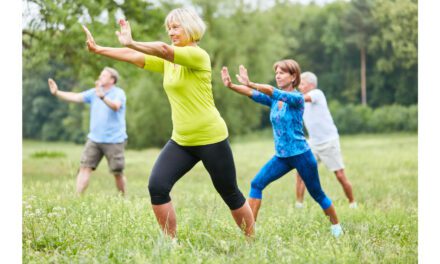By Karen Danchalski, PT, DPT
The benefits of mindful movement have been well researched in numerous medical, scientific, and health journals and the research is growing. In fact, it may surprise you just how much research there is out there. As mentioned in the first article of this series, The Case for Mindful Movement in PT, there are over 17,000 abstracts relevant to the study of energy medicine, mindfulness, tai chi, qigong, and yoga in the Qigong Institute database. The institute published a curated collection of these abstracts in their 2022 report, “An Introduction to Qigong Health Care – Meditative Movement Exercise for Whole Person Health,” which can be accessed through the National Qigong Institute.
Tai chi, qigong, and yoga have become increasingly popular ways to reduce stress; relieve anxiety; improve balance, flexibility, and strength; and improve quality of life. It is not uncommon to see these mindful movement practices offered at fitness centers, senior centers, and studios throughout communities. Physical therapists are likely to have patients who are concurrently taking classes, have questions about modifications and the safety of certain movements, or may just be curious if the practices can improve their condition. Therapists who understand the benefits of mind-body movement can either guide their patients to other teachers or use the principles and exercises in their own therapy sessions.
Listen to more about using mindful movement: Podcast: Mindful Movement with Karen Danchalski, PT, DPT
The benefits of mindful movement span physical, biological, mental, emotional, and spiritual dimensions, which is why these practices fit neatly within the biopsychosocial model of healthcare. The biopsychosocial model affirms that an individual’s health is influenced by more than just the biological nature of a disease. A person’s psychological state, attitude, beliefs, environment, social and family support, and relationships with healthcare providers all contribute to the patient’s health.
Modern medicine aims to treat the whole person, which includes not only prescribing medications, but also exercise and healthy lifestyle choices. Mind-body practices treat the whole system, not just a particular body part or injury. Tai chi and qigong are recommended by major medical institutions such as the Veterans Health Administration, Harvard medical school, and the American College of Sports Medicine for their emphasis on whole-body healing and well-being. By learning simple routines that can be done at home, patients increase their self-reliance on managing their own ailments and learn to become creators of their own health.
So what are the benefits? Are all of these benefits relevant to physical therapy? Are there specific diagnoses that respond better to mindful movement? There is so much to explore and learn. Let’s dive in.
Physical Benefits of Mindful Movement
Tai Chi, qigong, and yoga exercises can be single movements or a sequence of movements linked together that focus on body awareness, intention, and deep breathing. Moving in and out of specific postures or sustaining these postures improves flexibility, builds strength, and—according to a Tai Chi and Qigong systematic review in 2010—can improve bone density. The “ready position” in tai chi and qigong is the beginning standing posture for all movements. It requires the person to feel grounded through the legs, with a slight knee bend, spine aligned over pelvis with a slight tucking of the tailbone, shoulders relaxed, and head aligned over the body. Standing meditations, common in qigong, increase the patient’s self-awareness of posture, allowing them to feel and make subtle adjustments in their alignment, while at the same time building stamina in their postural and leg muscles. Standing routines often include squatting, weight shifting, static and dynamic balance and coordination, which have been shown to reduce falls in older adults. I like to point out to patients who feel like they are too sedentary that doing a simple qigong routine in standing for just 15 minutes can be quite the workout!
Qigong also incorporates neural tension principles, which it describes as “muscle tendon changing.” Therapists will notice that certain exercises appear very similar and have the same feel and effect as neural flossing and gliding techniques.
Relaxation Response
Tai chi, qigong, and yoga practiced purely on a physical level could be thought of as “light to moderate exercise.” One is simply moving the body and loosening up the joints and muscles. What makes mindful movement meaningful and so effective is the addition of deep breathing, focus, and intention. It is the combination of slow diaphragmatic breathing and mindfulness that stimulates the vagus nerve, thereby increasing parasympathetic activity.
The parasympathetic branch of the autonomic nervous system is commonly referred to as the “rest and digest” system. Under polyvagal theory, one can be in various states of sympathetic, ventral-vagal, or dorsal-vagal parasympathetic dominance. In a sympathetic, “fight or flight” dominant state, physiological changes such as increased heart and breathing rate prepare and mobilize an individual to deal with stress and danger. In a dorsal-vagal dominant state, the body is immobilized, can experience near somnolence or “freezing,” and can occur in patients dealing with trauma or depression. Mind-body practices place the patient into a ventral-vagal dominant state, which is a relaxed and alert state optimal for healing, growth, and restoration.
Through interoceptive skills such as conscious awareness of breath and body sensations, focusing on the present moment, and moving intentionally, the patient is put into a state of flow. In the flow state, the patient feels relaxed yet observant, calm yet focused. This ideal balance of parasympathetic and sympathetic activity is most favorable for healing and resilience. Although the practices mentioned in these articles have differences in origin—for example, yoga originated in India, Tai Chi was developed as a martial art, and qigong was practiced solely for the purpose of health—all of them elicit the relaxation response. Scientific research on the benefits of mind-body practices have largely centered on the relaxation response as the key factor in improving health.
Who Benefits from Mindful Movement?
Peer reviewed scientific research supports evidence in varying degrees that mindful movement can improve heart disease, hypertension, diabetes, osteoporosis, arthritis, chronic obstructive pulmonary disease, Parkinson’s disease, multiple sclerosis, and effects from stroke. Mindful movement can reduce falls, support cancer care, improve immune function, reduce inflammation and pain, and improve depression, anxiety, mood, cognition, and quality of sleep.
I have found qigong to be highly effective in patients with fibromyalgia, dermatomyositis, and other chronic pain syndromes. These patients often comment that the movements are more gentle, and open up and release their muscle tension better than traditional physical therapy exercises. The focus on slow diaphragmatic breathing and meditation also reduces their pain. I have used slow weight shifting exercises for improving balance and control in patients with multiple sclerosis and have done simple routines that challenge arm and leg coordination and improve mental focus in elderly clients.
Mindful movement is accessible to a large portion of the population because it is gentle, low cost, does not require large spaces or any equipment, and can be done by individuals at any fitness level. Routines are highly adaptable and can be done lying down, sitting, or standing. Therapists can use mind-body principles and modify exercises for patients of any physical ability.
In the next article of this series, I will discuss several mindful movement concepts and key verbal cues to use with your patients, review a variety of qigong routines, and cover things to watch for when patients are just beginning. I find doing the routines with my patients is fun and beneficial for my own health as well and can help prevent therapist burn-out. Stay tuned!
Do you have any questions for the author or commentary about how you would use these techniques with patients or do already? Sound off in the comments!

Karen Danchalski, PT, DPT, has been practicing physical therapy for 24 years. She currently practices in an outpatient orthopedic clinic and provides outpatient services in the home setting. Karen has a special interest in mindful movement, has been a certified Stott Pilates instructor for the past 10 years, and is a member of the National Qigong Institute. She integrates Pilates and qigong exercises into traditional physical therapy treatments whenever it can benefit the patient. She is the author of several articles written for therapists on the topics of exercise for seniors, pain, and personalized healthcare.
Main Photo: 159817381 © Robert Kneschke | Dreamstime.com
Read Karen Danchalski’s other posts in this series:





